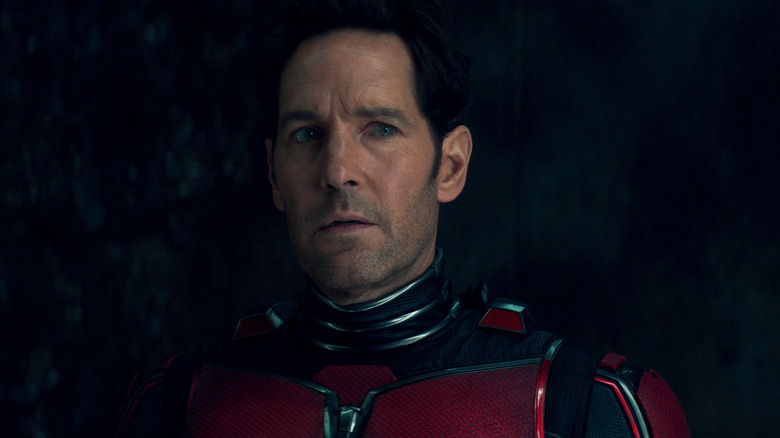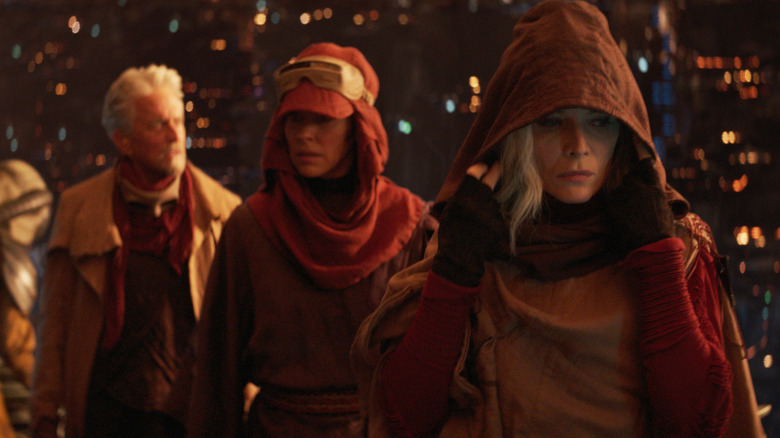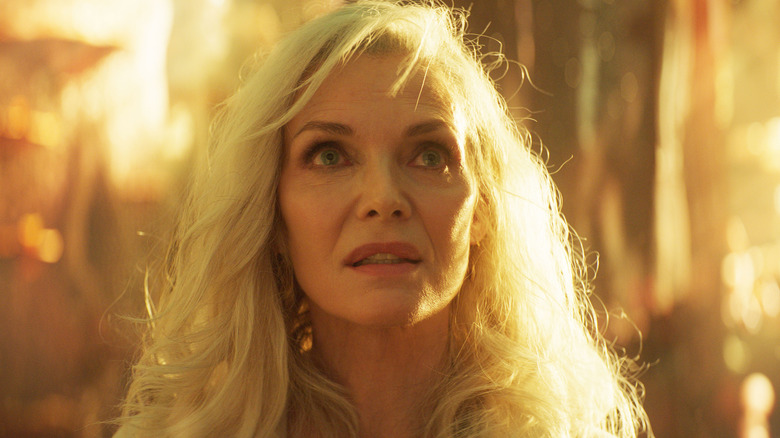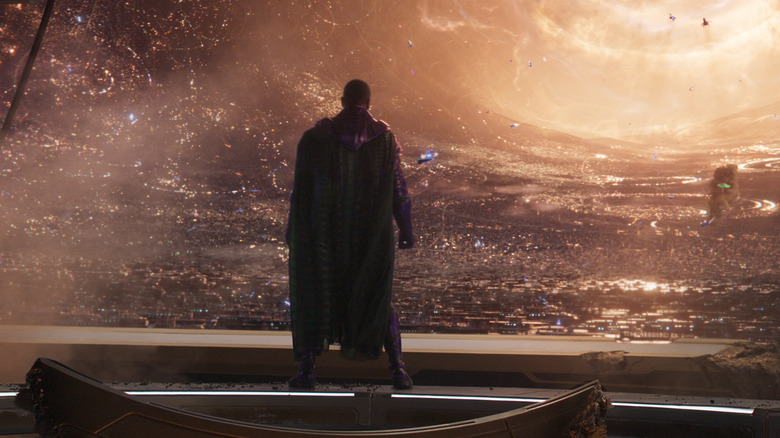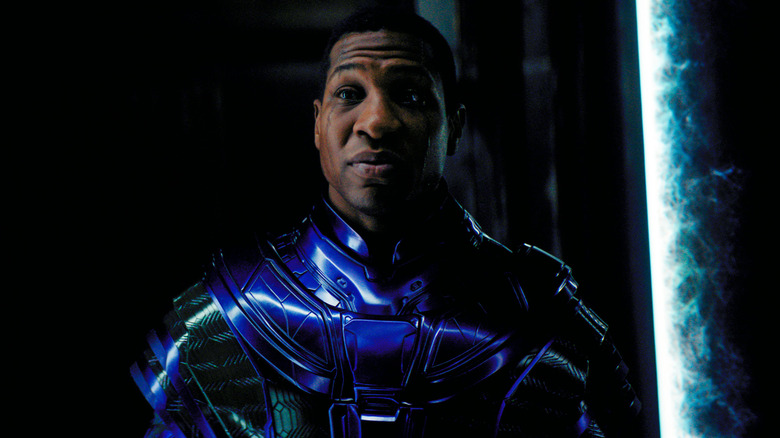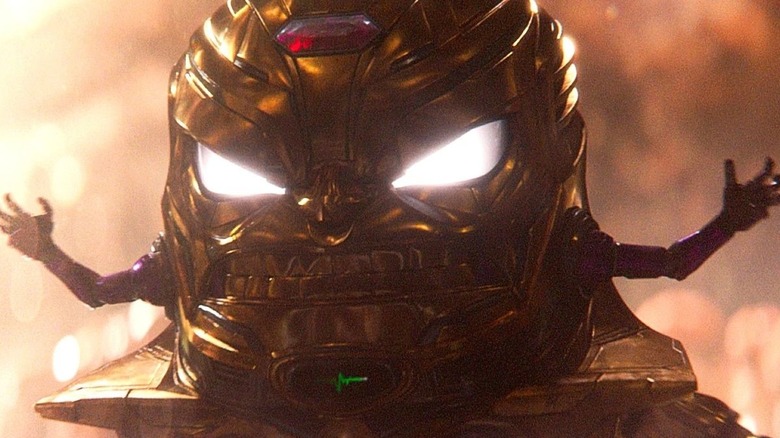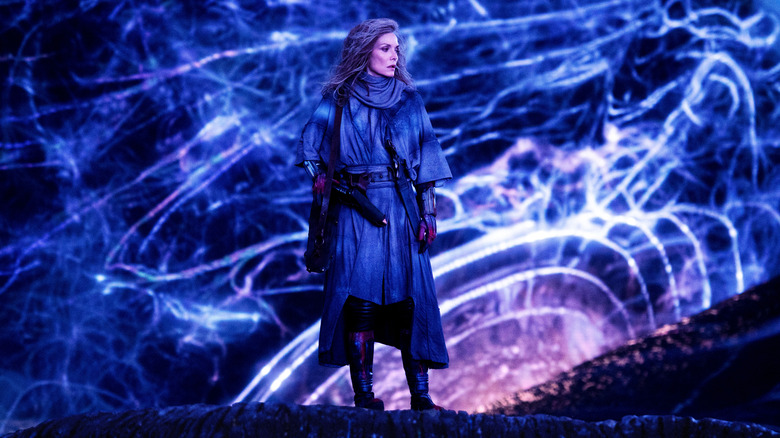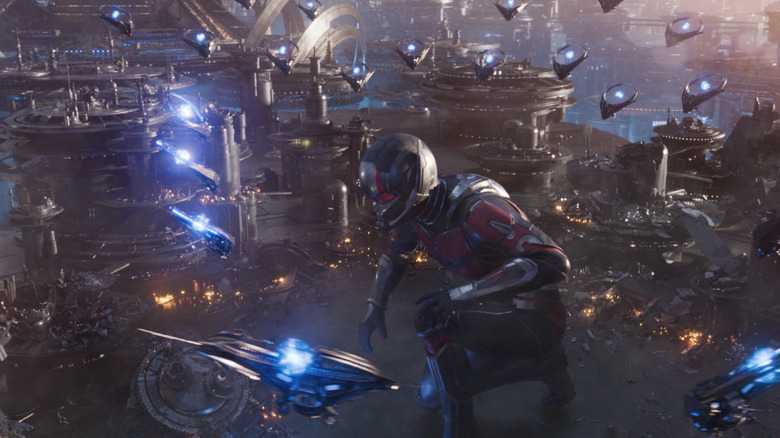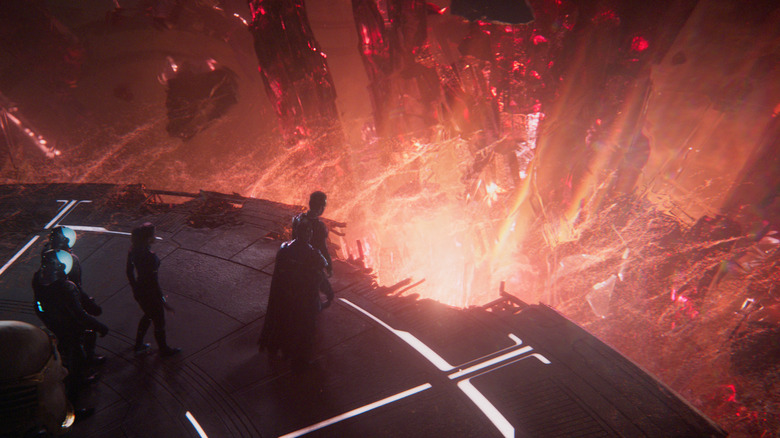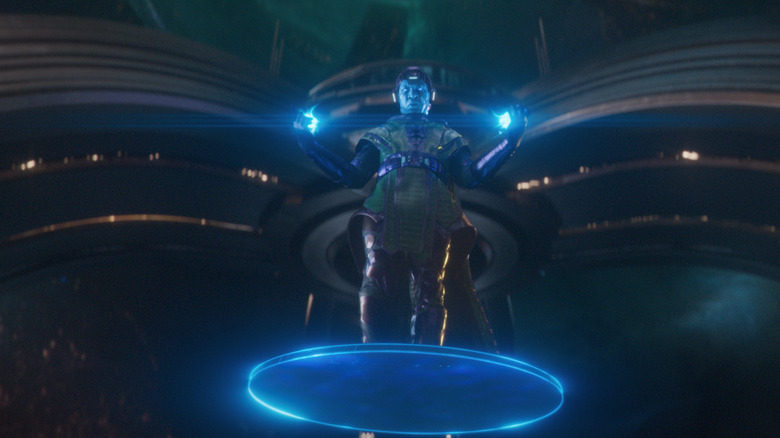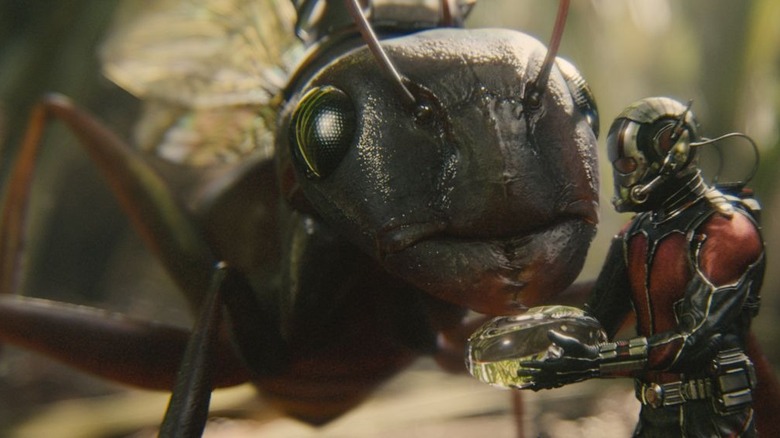11 Moments In Ant-Man And The Wasp: Quantumania That Make No Sense
This post contains spoilers for "Ant-Man and the Wasp: Quantumania."
"Who said life has to make sense?" asks Scott Lang (Paul Rudd), pointedly, towards the end of "Ant-Man and the Wasp: Quantumania." The implied answer is, of course, nobody, and thus we ought to let all the most preposterous aspects of the Quantum Realm, and Scott's journey through it, roll off our backs. If anyone thought that was a realistic possibility, however, they don't know comic book movie fans. We live to nitpick even the things we enjoy, and there's much to enjoy in "Ant-Man and the Wasp: Quantumania," from its evocative alien landscapes to its weird, nonhuman supporting characters.
Just because there's much to enjoy, though, doesn't mean it's necessarily coherent. There's a whole lot here that really doesn't make much sense, logically or even internally consistent. Maybe multiple viewings will remedy some of that, and perhaps access to the actual screenplay would clarify other items. In the meantime, however, we're left scratching our heads and palming our faces at several moments in the movie — most notably those listed below.
How do subatomic people breathe oxygen?
The Quantum Realm exists on a subatomic level, meaning anyone existing in it is smaller than standard atoms and molecules. Let's handwave away the whole idea of how Pym particles do shrinking and growing by shifting matter between dimensions, and assume it's a given. How exactly would a human breathe if he's smaller than an oxygen atom?
Earlier "Ant-Man" films had an explanation for this. Everything in the suit shrinks, including the oxygen supply, which means those O2 molecules in Scott's suit also get proportionately smaller and breathable. This, however, only works if one stays sealed in the suit at all times, like an astronaut. The moment the helmet comes off, the shrunken air would disperse.
Comics explain the situation better, in which the Quantum Realm is merely a portal to the Microverse, an alternate dimension with similar rules of physics to ours, that can only be accessed through the Quantum Zone. The movie doesn't explain it this way because "Microverse" is a term packaged up with Hasbro's Micronauts, whose film rights are at Paramount. Instead, the term "Quantum Realm" seems to cover at least two very different areas with different rules. The filmmakers may understand this, but if so they don't convey it very well.
What happened to Quantum Realm disorientation?
The theoretical different areas of the Quantum Realm come into play with this issue, too. What happened to Quantum Realm disorientation? In the first "Ant-Man," this was a huge safety issue. Entering the Quantum Realm, Scott quickly lost his bearings and started to go unconscious. He managed to recover in time through force of will, and thoughts of Cassie — and perhaps, via retcon, Janet Van Dyne (Michelle Pfeiffer) entangling her thoughts with his. It got pretty hairy there for a while.
So when Hank Pym (Michael Douglas) goes subatomic to find Janet, we know the stakes, and he nearly loses it. He's also pretty clearly in the Microverse area, rather than the portal part where Scott was, if we're differentiating. He's saved by Janet, who has mutated over the course of 30 years to absorb and emit quantum energy.
So why is quantum disorientation not a thing in the third film? It's never even brought up! There are a couple of possible explanations we may hear in a comic or novelization. The simplest is that after the snap and the blip, they collected a lot more healing particles in the Quantum Realm and immunized themselves. There's just one problem with that...
Why was Janet okay with sending Scott down there before?
When Janet learns that Cassie wants to send a signal down to the Quantum Realm, she freaks out. She knows Kang (Jonathan Majors) is down there, looking for something to grab onto. She never mentioned it before, thinking she'd never have to.
Yet in "Ant-Man and the Wasp," she's totally chill with sending Scott back down to the Quantum Realm to harvest energy particles for Ava/Ghost, the villain they just fought. Also cool? Sending radio signals down there to communicate with Scott while he's collecting particles. No warning, nothing. Scott then gets trapped down there for five years because Thanos' snap happens. He later says it felt like five hours, which is literally the only occasion we've seen time be as relative down there as initially described by Hank. Janet's 30 years clearly operated just like 30 regular years.
If she knew any signal in the Quantum Realm was risky, why send Scott down there just casually like that, and talk to him while he's down there? Even if she secretly hates him, the Kang risk factor would seem just as strong. Come to think of it, how come Kang or MODOK didn't notice Scott in there for five whole years, since time where he and Janet were at seems to run totally normally?
What Kang offers can already be done
New arch-villain Kang is a master of time and space. As such, his seductive pitch to Janet — and maybe implied pitch to Scott, if he ever got around to actually making it — is he can offer the impossible. He can return an estranged parent to the exact moment in time they left their kid, thus allowing them to get back all the years they lost. Janet missed 30 years of Hope's life; Scott lost five from Cassie (Kathryn Newton).
It's a great offer, but, uh, does anyone remember "Avengers: Endgame"? The Avengers can already time travel to specific points. Technically, occupying these and changing events will create variant time streams that the TVA might come and shut down (or not, since an evil Kang variant apparently runs it as of the last "Loki" episode), but Janet and Scott don't know that. What they do know is that Scott has in fact time-traveled before, and can do it again if needed. Kang doesn't seem to get that in the Marvel Cinematic Universe, the time travel part is small potatoes. It's restoring youth that's the really hard part.
How does Kang know anything about Scott?
When Kang first meets Scott, he seems not to know him. The questions he asks (Have I killed you before? Are you the one with the hammer?) could express ignorance, but they actually appear to be just mocking taunts when the Conqueror proceeds to address him by name. His real one, and his superhero one. But how did he know?
Most of Kang's knowledge comes from Janet during the period when they were friends, and perhaps more. Presumably, Janet didn't know Scott then. Sure, time works differently in the Quantum Realm, but the implication of Janet's conversation with Krylar (Bill Murray) is that she's been a rebel fighting Kang for quite some time. In that time, she's only known Scott from their brief entanglement in his initial Quantum Realm encounter. Based on her history, she would have told Kang that Hank was Ant-Man. Maybe Kang simply asked Scott a lot more questions off-camera. Or, is he going off what he learned from a variant in another timeline?
How does MODOK make any sense at all?
At the end of "Ant-Man," Scott Lang tampered with the Yellowjacket suit worn by Darren Cross (Corey Stoll) so that it would shrink to a subatomic level while his body remained the same size. In theory, this should have crushed him to death. In practice, apparently, it left him in the Quantum Realm with a huge mutated head, relative to his other proportions.
Regardless of exactly what fake science justifies, anything compressing a person's body that small relative to their head will crush the internal organs. Advanced future science or not, Darren ought to be dead immediately, and impossible for Kang to save him. Plus, again, no closed suit means no air supply. And this time, there's no proximity to Janet that might have helped or a magic beam from the Quantum Realm.
MODOK is the highlight of the movie, giving Darren a weirdly childlike sensibility in addition to his murderous nature. As such, he can be cut some slack. Let's face it, there isn't any version of MODOK that makes much sense. We're just saying this one really, really doesn't.
How many Pym particles did they bring, anyway?
When the entire family gets sucked into the Quantum Realm, they are unprepared. It's sudden and unexpected. They weren't even prepared to fight crime. Yet throughout the story, Ant-Man, Wasp, and Cassie have their suits powered up and all the Pym particle-throwing stars they need.
For the sake of superhero logic, okay, apparently they keep their super-suits under their clothes at all times. This is way easier to buy with Superman, who uses thin, super-spandex from Krypton than with normal humans wearing Quantum spacesuits. Let's assume, though, that by dimensional magic, they're super-thin when not in use as well. Fine, conceit accepted.
Exactly how many of those throwable Pym particles do they have on them at all times, though? Those things are dangerous, as they appear to operate on impact. So if a person carrying one happens to fall down on it, might that not set it off? They are basically loaded guns, with arguably more drastic effects. Still, any time any of our heroes needs one during the movie, they can pull out a handful. Were they preparing to use them on each other if family arguments got too heated?
Why don't they just use the particles to grow to normal size again?
If they have all these Pym particles on hand, why not, you know, use them? Grow full size! That's the ticket out of there, isn't it? Grow back to regular size real quick, smash Cassie's machine, and MODOK and Kang stay stuck down there.
Again, this would seem to go back to not fully explaining how the Quantum Realm is derived from both a conduit and another dimension. If it's only in the conduit part that growing or shrinking makes the difference, fair enough. The movie is simply not very clear about this distinction, especially compared to what happened before.
Come to think of it, if Kang's technology is so far-future advanced, why can't he make Pym particles? Or grow really big? These would seem like no-brainers. Sure, in the present, Hank Pym is so brilliant that only he can make that stuff. Centuries in the future, though, even the most brilliant bits of present-day tech will feel like old hat. Unless Kang is actually, like many of us, just using off-the-shelf gadgets without necessarily knowing how they work.
What's the deal with the energy core?
Let's see if we get this right: Janet throws Pym particles at Kang's energy core and it gets huge and breaks the container, which also grows but remains cracked. But even though it's now giant, Scott has to shrink down to go inside it and get it. Then, they beat Kang by shrinking it again, but because he's in close proximity to it when it shrinks, he shrinks, too, and presumably dies because he doesn't have an Ant-Man suit. Is that right? And even if it is, does anyone think the movie explained it well?
Since when did things being next to a shrinking thing shrink, too? Moreover, if ants can shrink with no ill effects, why can't Kang? Of course, we don't know for sure this Kang is actually dead; we have only the words of other Kangs to take on that. It is nonetheless a fate that requires not asking too many questions at the moment.
With so many Kangs, who cares if that one gets out?
Kang the Conqueror is reputedly the worst Kang; a genocidal monster who must not escape the Quantum Realm. Releasing him would unleash havoc and destruction upon the multiverse.
Except ... there are already many more of him outside. The one that replaced He Who Remains in "Loki" was also supposed to be the worst one. Apparently, all the other Kangs combined can defeat the Conqueror, too. In the mid-credits scene, it appears they're more pissed off that a human killed the Conqueror than they might have been had the Conqueror escaped and they had to put him back there again.
Quantum Realm Kang's defeat matters to the people of the Quantum Realm, though if Darren freakin' Cross could survive a ruptured suit shrinkage, Kang surely can as well. But if there are already infinite Kangs messing with time anyway, why does one more really matter, especially if they all enjoy fighting and killing each other?
Ant evolution doesn't work that way
Screenwriter Jeff Loveness used to work for "Rick and Morty," and it shows in one of the climactic plot points. Ants sucked into the Quantum Realm by MODOK went into a different timeline, and had thousands of years to evolve, creating their own high-tech society of giant ants. By the time Kang is ready to escape, they've become advanced enough to come and assist Hank Pym in his battle. It's a funny gag and a replay of sorts of a "Rick and Morty" episode that did more or less the same thing but with snakes. But is it plausible? Not really.
For one thing, it would take tens of millions of years for ants to change; they've been around since the time of the dinosaurs, evolving from, ironically, wasps. For another, if the Quantum Realm's gravity is anything like Earth's (and we have no evidence that it isn't), giant ants would be non-functional at that level of mass and in those proportions. Also, evolution works towards maximum efficiency in an environment, and ants are already operating at close to peak — there's no compelling biological reason for their species to change what works especially well for their survival. It's also pretty hard to build human-style technology without opposable thumbs.

